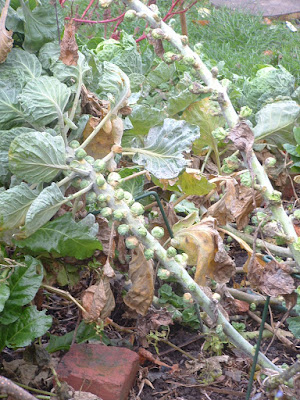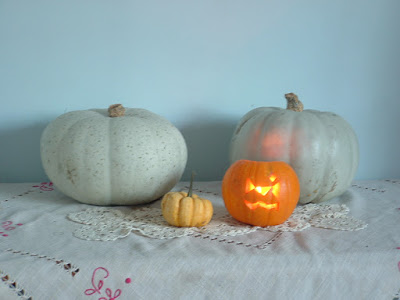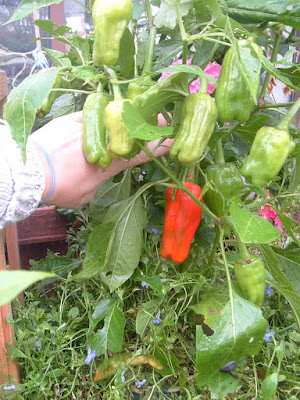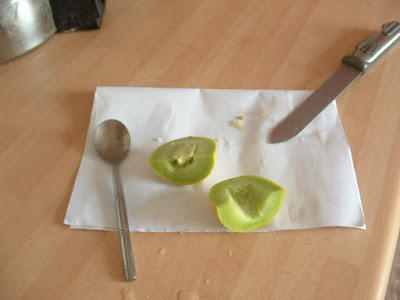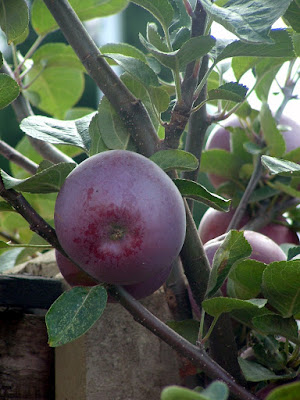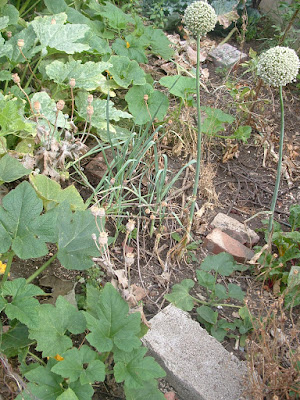 |
| Laxton Fortune, Sep 2018 |
Roots
Harvested the last of the carrots in planters (transplanted lettuce seedlings after them).
Beets and celery still in the ground. Leeks still growing slowly; old season leeks putting out new growth and newest little plants (from this summer's bulbils) small but growing.
Peas and beans
Harvesting about a handful of French beans once per week in September and even fewer runner beans.
One volunteer broad bean plant up and growing.
Cleared away the mange tout vines and collected a handful of seed.
Brassicas
Took insect mesh off all remaining brassicas at the beginning of September; no real damage from caterpillars this month, though a few butterflies around.
Planted out two Savoy cabbage cuttings (very small). Savoys (from seed) at the allotment are a bit bigger and well established now.
Brussels sprouts very big and falling over--need staking! Same with curly kale; harvested a little of this but not sprouts yet.
The young cauliflowers which were overwhelmed by squash vines have mostly disappeared--only a couple left. One larger, last season plant still determined to form a head, but only slowly.
Purple sprouting broccoli plants growing well; two have been staked, though the rest need it also. None harvested.
One kohlrabi has a nice little bulb, the other has only a very slight swelling. None harvested.
Miscellaneous
All but about three lettuces gone to seed by the middle of September; new seedlings have been transplanted out in planters and in the ground (keep disappearing in the ground though). Still harvesting a few spring onions this month, also from planters.
Harvested five sweetcorn cobs, but disappointing flavor; picked too late, I guess--they were completely hidden by achocha vines. Still harvesting modest amounts of achocha all this month.
Still harvesting ripe tomatoes regularly all through this month; cherry tomatoes pretty much finished by the end of September, but still more regular tomatoes on the plants. A couple more tomatillos formed this month, but none harvested.
Picked five lovely green squashes, and one small pumpkin in September. Still at least one green squash growing.
Picked a few small patty pan squashes, but no zuccinis. Melon plant formed one small melon and then wilted, just like the cucumber plants did in July.
Harvested several bunches of Aztec broccoli all through the month, and good amount of chard too. Cleared away chard left for seed; put down the plants (with seed heads still on) in several locations around the garden, including the perennials section.
Little peppers still growing this month, with a couple starting to turn colors; a couple more tiny chilis formed. None of these harvested.
Fruit
Finished harvesting the figs (a couple per week) by the middle of the month. Harvested the plums and Laxton Fortune apples over a period of a few weeks. Started picking almonds and Sparta apples by the end of September.
Picked the one remaining nectarine after it, like its compatriot, split from a hard rain and started to go moldy. Although it wasn't fully ripe, it was either eat it or throw it away--and after waiting four years I wasn't prepared to chuck it! Not particularly impressed, though.
Picked all the unripe pears off Williams (only three decent sized) after the tree trunk completely snapped from high winds; that's it for Williams, I think.
Yellow raspberries dried up without fully ripening--been a very dry summer, and hard on all the raspberries; a couple more flowers formed this month, however.
Transplanted two strawberry plants to the allotment.
Perennials and herbs
Still picking small amounts of chives, parsley, basil, and mint.
Artichokes still standing but not producing. At least one asparagus plant has been spotted (no bigger than it was this time last year though). Sorrel regrowing after hard chicken pressure over the summer, and one small rhubarb shoot spotted.








